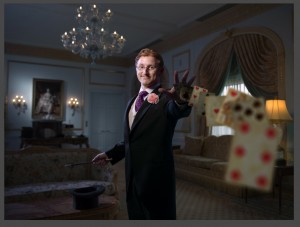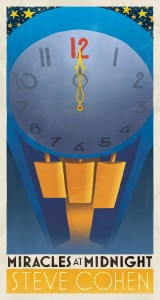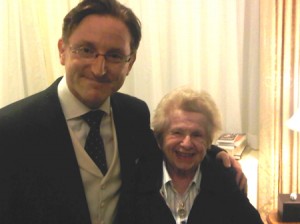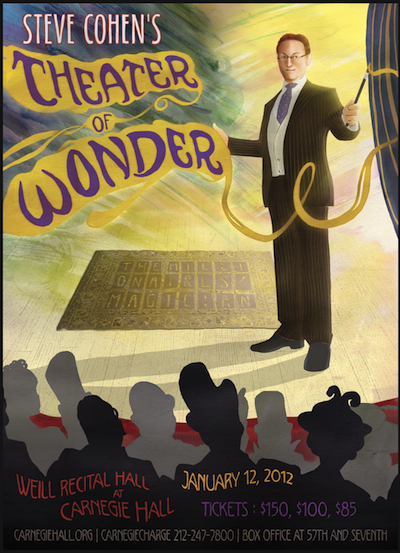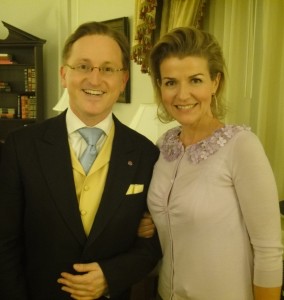Society of American Magicians’ magazine cover story, November 2011
November 15, 2011
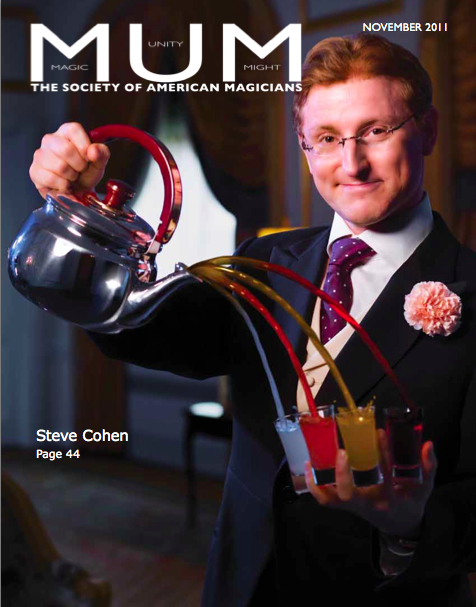
How Steve Cohen Got To Carnegie Hall
by Antonio M. Cabral
M-U-M magazine, November 2011
“What is a true secret? Something that is there for everybody to see—and one recognizes it, the other doesn’t.”
—Lao-tse
Magicians and secrets have a funny relationship. The normal people who comprise our audiences watch us perform miracles and cannot begin to imagine how a person might learn the requisite techniques and other arcane knowledge to accomplish the impossible. Magicians on the other hand know all about the vast oceans of literature (in print and on film) obsessively detailing and documenting the history and lineage of all these bizarre, clever and wonderful ideas. They know you can walk into a magic shop and buy whatever you like without having to fight a dragon or some other kind of mystic wizard’s trial. They worry that their audiences will run home after watching a performance and look for the explanations on YouTube. The “secrets” are out there, if you care enough and know where to look. And yet, magicians and laymen can look at the same “miracle” and both be mystified—if for different reasons.
For example, many close-up magicians know the story of Max Malini’s famous production of a brick or a block of ice from under a hat as recounted by Dai Vernon in Stars of Magic. Vernon was tasked with watching Malini over the course of an evening’s dinner performance to try to pin down the little man’s sleight-of-hand secrets—in particular the the block-of-ice-under-the-hat trick. Throughout the full evening’s meal, Malini never left the table. Malini then proceeded to perform the trick and “…when Malini lifted the hat, a block of ice the size of four fists lay in the center of the table […] Vernon swears to this day that ‘The little bugger had no time to load up.’” While the regular audience members wondered how the ice got under the hat, Vernon was dumbfounded as to how the ice got to the table at all. A bribe to the waiter proved unsuccessful, and they never found out from where Malini had procured the ice.
On the other hand, whenever Steve Cohen performs the trick as the opener of his exclusive Miracles At Midnight show, the source of the block of ice is somewhat less of a mystery. The show is his second as part of his residence at the über-opulent Waldorf-Astoria in Manhattan. The kitchen at the Waldorf-Astoria is located on the second floor and takes up the area of a full city block. “They have a huge walk-in freezer, and they’ve let me have a whole shelf in there just for blocks of ice for this trick. I used to go down myself to fetch the ice, but it gets so cold in that freezer that our arrangement now is that I simply ring down to the kitchen and they run one upstairs for me at the beginning of each show.” Of course. Everything’s easy once you know the secret.
But while Steve’s audiences—like Malini’s—are astounded at the appearance of the ice under the hat, magicians marvel at something else. They don’t marvel at how the ice appeared under the hat or how the ice got to the table, but at how Steve Cohen himself has managed to “magically appear” in residence at the Waldorf-Astoria with not one, but two elegant, high-end magic shows—one of which costs $250 per person. For close-up magic! And coming this January, Steve will be premiering a stage show at a local Manhattan venue named Carnegie Hall. Compared to those “miracles”, blocks of ice and bricks under hats might as well be the old stretching thumb trick your uncle does…
“I remember once hearing one of my younger brothers telling his girlfriend my story […]—I was born, I was talented, I got into piano, I had this neat place and I worked with Miles Davis. He left out this GIANT part which was the STRUGGLE!”—Keith Jarrett
Steve Cohen’s success is unparalleled. His client list reads like a listing from Forbes—in large part, because it IS. Then there’s his residence at the Waldorf-Astoria, where he performs two elegant and exquisite evening shows of classical parlor conjuring. Chamber Magic is his now well-known, eleven-year-running weekend parlor show, and since 2010 he’s added Miracles At Midnight, a $250-a-head evening of close-up performed only once a month and billed as “The World’s Most Exclusive Magic Show”. And like many of magic’s great secrets, the secret to Steve’s success is hidden in print. He’s detailed much of the story of his journey from young birthday party magician to The Millionaire’s Magician in his 2008 Genii Magazine cover feature, his interviews with The Magic Newswire website, and his own book for the lay public, Win The Crowd. And Steve still receives enough emails from eager magicians wanting to set up residence performing at swanky hotels (because “it worked for THAT guy!”) that last year he put a very frank post up on his Chamber Magic Blog addressing these emails in general. It’s titled, “How NOT to start your own one-man show” . And in it, he explains some of the secrets to his success.
Put in magician’s terms, Steve’s success at the Waldorf-Astoria boils down to a lot of “pre-show work”. While his identity as The Millionaire’s Magician is a relatively recent creation, he got his very first experience performing for the “upper crust” at age 17, performing for the Rockefeller family on their estate. During his four years living in Japan, his connections made from attending Cornell led to him performing weekly at the 5-star Park Hyatt Tokyo. He was already an experienced and successful performer when he decided, with the help of his creative partner Mark Levy, to reinvent himself and his repertoire as “The Millionaire’s Magician”. He’d already had an act when he decided to put together his first Chamber Magic shows. He’d already been performing his Chamber Magic show every week for many months in other venues before approaching the Waldorf-Astoria. Also, by his own admission, it took two years of self-support and losing money on the show, and three or four before he’d proven the show successful enough to the hotel that they began to help promote him. So, in the same way a mentalist can point to any random audience member and appear to instantly pluck their secrets from their mind, Steve Cohen is an “overnight sensation”. Easy, when you know the secret. No one can simply waltz into the Waldorf-Astoria and put on a magic show, anymore than one can really pluck thoughts from people’s brains
And Steve’s not the only one tipping his mitt on the Internet. Marketing guru Seth Godin, on his own blog, put together a succinct-yet-insightful five-point list of how Steve has achieved the success he has (“Giving away a magician’s secrets”). Points One, Two, and Four are savvy marketing skills. Number Five on that list is “He’s very good at his craft. Don’t overlook this point.” And while Chamber Magic and Steve’s existence as “The Millionaire’s Magician” are very much the result of intelligent and focused marketing efforts, when all is said and done sustaining that image involves being a consummate performer. When you watch Steve perform, it’s impossible to overlook the fact that he’s very good at his craft. He ought to be by this point; he’s been performing magic professionally since the age of 10, is a veteran of Tannen’s Magic Camp, and has performed his Chamber Magic show alone by his own estimation over three thousand times. If you watch closely, you can see all of that experience manifest in his three shows: Chamber Magic, Miracles at Midnight, and the brand-new, upcoming Theater of Wonder.
Chamber Magic
When Steve set about creating Chamber Magic, he’d already had to reinvent his repertoire to fit his image as The Millionaire’s Magician. Tricks he’d been performing successfully for years got retired as Steve now focused on tricks that spoke to wealth and affluence—tricks with real diamonds, $100 bills, gold…your standard everyday household items. When the time came to create Chamber Magic, he knew he wanted to create an evening of elegant, refined magic that harkened back to the Viennese salons—a stylistic choice that was a good fit in the venues he aspired to and spoke as much to the “lifestyles of the rich and famous” as any choice of props. More importantly, thought, Steve knew what kind of show he didn’t want to do.
Around the time Steve was conceiving Chamber Magic, his friends were telling him about the great success Ricky Jay was having with his evening show, Ricky Jay and His 52 Assistants, an evening of nothing but card tricks. Without even seeing the show, Steve immediately knew that trying to launch a similar evening of only card tricks would invite inevitable comparisons—“apples to apples”—and Steve wanted to offer something exclusive and unique. While Chamber Magic does open with a selection of flourishy sleight-of-hand with cards, once he’s established his skill Steve deliberately moves away from sleight-of-hand. While 52 Assistants wears its sleight-of-hand on its sleeve, Steve wanted a show of close-up and parlor magic seemingly devoid of any sleight-of-hand whatsoever.
On the other side of that coin, while Chamber Magic features some very powerful mental magic, Steve didn’t want a full evening of mentalism, either. He’s not a mentalist; he’s a magician who can read minds. So the show would ultimately be a fine-tuned mix of prestidigitation (like the opening card tricks and the Malini Ice Under The Hat) and more inexplicable mysteries (linking wedding bands, an astounding presentation of the Rising Cards, and the aforementioned feats of mind reading). The program states that the show begins with “Precision technique which has no equal” and ends with “An enigma of the highest order”. A well-crafted crescendo of effect to be sure—but it doesn’t stop there.
Point Number Three on Seth Godin’s list is “He intentionally creates an experience that is remarkable and likely to spread.” Thanks to Steve’s decades of experience as a performer, Chamber Magic was designed with that idea firmly in mind. Steve recalls a conversation with Jeff McBride about what an audience wants to take away from a performance of magic. “His answer was they want to be able to say ‘It happened to ME!’” In Chamber Magic, Steve manages to squeeze every drop of audience involvement out of his act—not just participation, but involvement. Take for example one of the opening effects, a bit of mind-reading with cards. Steve has someone from the audience remove a handful of cards from a shuffled deck and proceeds to divine each and every card one-at-a-time as the audience concentrates on them. Where most performers would perform this with a single person while the rest of the audience looks on, Steve has the first person focus on a card, divines it, then has that person pass the cards to another member of the audience. This continues until all the cards have been divined. While the normal audience marvels at how he could possibly know what card they’re each thinking of, the real trick is getting each audience member to think, “I could be next!” Even the initial shuffling is done not by one, but by several members of the audience. Magicians like to refer to their audience members as “spectators”. Steve recognizes the importance of not allowing his audiences to simply “spectate”.
This thinking permeates the entire evening’s performance. For his signature performance of Think-A-Drink, each and every member of the audience writes down their favorite drink. Even though only five or six drinks are eventually poured, the entire audience of fifty or more people feels like their drink of choice could have been next. In a recent performance on tour at the Beverly Wilshire hotel in 2010, Jason Segel (of How I Met Your Mother, Forgetting Sarah Marshall, and The Muppets) assisted Steve with Think-A-Drink. He was offered any choice of drink, with every opportunity to change his mind, and when Steve began pouring the chosen drinks, the 6’ 4” comedian’s reactions were as loud and boisterous as any he’s delivered on TV or in film—and genuine. And that’s the whole idea: to make the audience feel like they could’ve dictated the outcome—”that they could’ve affected the show.”
Another key factor to the way audiences experience Chamber Magic is laughter. Steve’s rule of thumb is that every couple of minutes (if not once-a-minute) there needs to be a laugh of some kind. Not knock-down, fall-over-yourself comedy—because that’s not Steve. But Steve finds that some kind of laugh or joke along the way helps everyone to relax and enjoy the experience with each other. By the time he gets to the end of a performance and is into the finale—his version of Juan Tamariz’s Total Coincidence—he asks the audience, ‘Should I STOP, or CONTINUE?’. In the performance I attended, everyone was laughing and shouting together ‘CONTINUE!’ “It really brings the whole audience together.”
Even the strict dress code is in place to enhance the experience. “When people have to get dressed up for an evening out, it makes them feel like they’re experiencing something special. Even the trip through the Waldorf-Astoria to the suite where I perform gives the feeling of something unique. Everyone feels like they’re sharing something important.”
It’s this kind of thinking that’s allowed Chamber Magic to enjoy a very successful eleven-year run, one Steve plans to extend to twenty, and then retire the show. He’s only mentioned that part in a few places, but from the beginning that’s been Steve’s plan for the show—a forward piece of thinking that will no doubt leave a few folks disappointed in nine years.
Miracles At Midnight
What more could any magician ask for beyond a show as distinctive and successful as Chamber Magic? Where does one go beyond the penthouse? Enter Miracles At Midnight. In 2009, David Kaye (aka Silly Billy) went to see Steve’s Chamber Magic show. After viewing Steve’s performance, David’s business sense for all things magic kicked in, and he made the suggestion that Steve ought to have “a luxury show” to offer his clients. After the high-end experience of Chamber Magic, what could possibly count as a “luxury show”? “This was in the middle of a recession!” But Steve liked the idea, and the result was Miracles At Midnight.
Performed only once a month in the Waldorf Towers, Miracles At Midnight is an exclusive, expensive, and late evening of intimate miracles. Where Chamber Magic is a parlor-style performance for a typical audience of 40–50 people, Miracles At Midnight allows Steve to indulge in his love for close-up magic for an audience of no more than twenty. “Because of the high price [$250 a ticket], the size of the audience is smaller than Chamber Magic, so I get to do the kind of close-up tricks I love but that don’t quite fit into Chamber Magic.” This includes items familiar to most magicians like Coins Across, and the Newspaper Tear. Speaking about the Newspaper Tear, Steve was initially reluctant to include the routine because of its popularity with other performers (again, avoiding the “apples to apples” comparisons), “…but the reactions it gets are too strong! It’s such a powerful trick.” Steve combines these more intimate tricks with some favorites from Chamber Magic. And like Chamber Magic, the key to justifying the $250 per ticket for Miracles At Midnight is creating a unique experience for all involved. To that end, another feature of this show not found in Chamber Magic is a segment where the audience is invited to bring up their own belongings and personal items, whereupon Steve performs miracles with those very items. Of course, to really “improvise” would risk doing something less-than-spectacular, and Steve will not let that happen. “It has the feeling of improvisation, like I’m making up the tricks on the spot. Of course, certain objects trigger certain tricks for me, like a jazz musician follows the chords and has certain ‘licks’ and can always come back to the form of the song. But for the audience it’s like I’m creating something for the first time, right in front of their eyes.” Steve also notes that most audiences tend to offer up the same objects (keys, jewlery, etc.), so he never has to worry about being confronted with anything particularly bizarre or unusual.
Which is not to say spontaneity doesn’t rear its head on occasion. On one such occasion, one of Steve’s guests was Dr. Ruth Westheimer. For the “improvisational” part of the show she offered a tube of lipstick. Steve proceeded with a trick similar to the Ashes On The Palm that he does whenever someone offers lipstick. With a twinkle in his eye, Steve asked the noted sex therapist, “Dr. Ruth, I’d like to perform something called a ‘penetration effect’. Would you like to see that?” Which of course delighted both Dr. Ruth and the rest of the audience no end.
Far from being prohibitive, the price tag and exclusive nature of Miracles At Midnight have attracted an equally high-end audience. Noted conductor and pianist André Previn celebrated his 80th birthday in attendance at Miracles At Midnight. Whenever people bring up the late start time of the show, Steve tells them that an eighty-year-old man came and stayed awake through the whole night—and enjoyed himself.
Theater of Wonder
Where does one go beyond the penthouse? In January 2012, Steve will debut Theater of Wonder at Carnegie Hall. The story behind the inception of this new show is in many ways a textbook example of the world Steve has created for himself, although again, as a “secret” there’s not much to it.
One of Steve’s clients, patrons, and good friends is renown classical violinist Anne-Sophie Mutter. The September 2008 Genii Magazine cover feature on Steve recounts how, at a private performance in Switzerland, Steve followed his staple performance of the Himber Linking Finger Rings by linking a violin bow onto the strings of a violin and presenting the object to Ms. Mutter as a souvenir. This is how fast friendships are made. In 2010, the two were having lunch and Ms. Mutter stated that she firmly believed that, as someone she considers a “world-class artist”, Steve should have a much wider audience. She pointed out to him that while he could certainly stick to his 20-year plan and continue to enjoy success, it wouldn’t allow him to grow as an artist. Her advice? “Think BIG!” And by way of example, she pointed out “Look at me: I’m playing Carnegie Hall tomorrow night.” Rather than wonder what he could accomplish that as big as playing Carnegie Hall, Steve took her literally. “I called my creative partner Mark Levy and said, ‘I want to play Carnegie Hall. Are you in?’ He said, ‘Absolutely.’”
(Steve is actually no stranger to Carnegie Hall. He’s performed there several times before—backstage. Whenever Anne-Sophie Mutter has played there, she’s invited Steve to perform for her guests after the concert upstairs in the Maestro’s Suite.)
Of course, no one simply walks into Carnegie Hall and starts performing magic—any more than they can simply walk into the Waldorf=Astoria and put on a magic show. Luckily, through his performances Steve had a contact at Carnegie Hall who arranged for them to tour the facility to get a feel for the venue. First step was to head to the main stage—the Perelman Stage in the Stern Auditorium. This is the stage people picture when they picture Carnegie Hall, open since 1891 and seating 2,804 people. Mark walked out into the center of the house and Steve walked to center stage. Once in place, Steve held up a playing card. “It looked like a postage stamp.” It became readily apparent that the sheer size of the hall would present significant problems for a performer used to working in more intimate venues. “2,800 is all right, but those last four are on their own!” Moreover, Carnegie Hall won’t allow any performer to hang projection monitors to aid visibility, killing the possibilities for any kind of close-up material.
Carnegie Hall also has strict regulations governing what performers are allowed to do on stage. Nothing can be done with fire, nothing with livestock—which would kill 90% of most large Vegas-style illusion shows. Most restrictive for Steve: nothing with liquid. That means while Steve could have a bottle of water with him onstage, his signature performance of Think-A-Drink gets left behind in the suite at the Waldorf. If all this sounds like an opportunity to dust off the Zig-Zag and the Substitution Trunk and hire some of the Rockettes to get sawn in half, consider that any and all onstage assistants would need to be provided by the union, which would drive the cost of the show up nearly $400,000. That’s a vastly expensive difference for a man who’s made his world-class reputation as a one-man show.
It would be tempting for any performer to reconsider, give up and try to find another venue more accommodating to the magician’s repertoire. However, any other venue isn’t Carnegie Hall. In truth, Steve did reconsider and find another venue, and that venue was…Carnegie Hall. Carnegie Hall features three stages: the aforementioned Perelman Stage, the more recently-built Zankel Hall and the Weill Recital Hall. The Zankel Hall was constructed in 2003 and seats 600—a more manageable size, but built in a more modern, austere “shoebox” style. It’s a beautiful hall for a modern jazz performance, but it doesn’t say “Chamber Magic”. The Weill Recital Hall, on the other hand, seats 300 while looking like a miniature version of the Stern Auditorium. With gilt-accented columns, ornate drapery, and crystal wall sconces, not only is it exactly the sort of backdrop Steve is accustomed to, at 300 seats it’s also an audience size he’s performed for many times before. Suddenly, the daunting expanse of Carnegie Hall becomes an almost bespoke fit for Steve’s brand of Victorian-flavored, classical conjuring. (Note: if you’re interested in “touring” the various spaces for yourself, carnegiehall.org offers virtual 360º panoramic views of each of the three different spaces that allow you to scroll around if you were standing right in the middle of the halls themselves.)
Now that he was comfortable in the space, what would Steve put into this new show? Steve is understandably reticent about the contents of the new show, but one thing it definitely will be is entirely new. He’s still contractually subject to the same performance restrictions, so Think-A-Drink is still out. There will be some mind reading (a strong way to play to a large audience), but again Steve does not want to mount a full-evening’s performance of mentalism. So for the first time in a number of years he gets to create a wholly new show. With 11 years of performing Chamber Magic, though, Steve feels he has a terrific advantage in envisioning the shape, rhythm, and flow of a succesful show. In fact, he’s managed to devise a unique framework for Theater of Wonder, running from the beginning moments of the show, providing a connecting thread for all the effects and culminating in a truly grand finale. On top of which, it draws from all aspect’s of Steve’s experience, resulting in a very personal presentation. Steve told me that when the idea came to him and he fleshed it out, he was so excited by it that he actually jumped up and down. For now, though, until Theater of Wonder debuts in January, the details remain…a secret. But not for long after, as with a 300-seat capacity and a 30,000-person mailing list, Steve fully expects the show to be sold out by the time this article sees publication. But the plan afterward, if the show proves successful, is for Steve to tour with the show, cross-promoting the stage show with performances of Chamber Magic in suitable venues in different cities.
The secrets of Steve Cohen’s success aren’t all that secret. Then again, they’re not all that easy. Like the most difficult sleight-of-hand, the “answer” may be simple, but only after years of experience, dedication, and attention to detail. There’s a joke that’s likely been in the mind of every reader since they started reading this article. It’s a joke about Carnegie Hall that scientists have proven to be older than the hall itself:
A man gets into a cab in New York City and asks the driver, “How do I get to Carnegie Hall?”
The cab driver replies, “Practice!”
It shouldn’t surprise anyone that after years of success, Steve will find himself onstage at Carnegie Hall. And he should do well. After all, he’s had plenty of practice.
